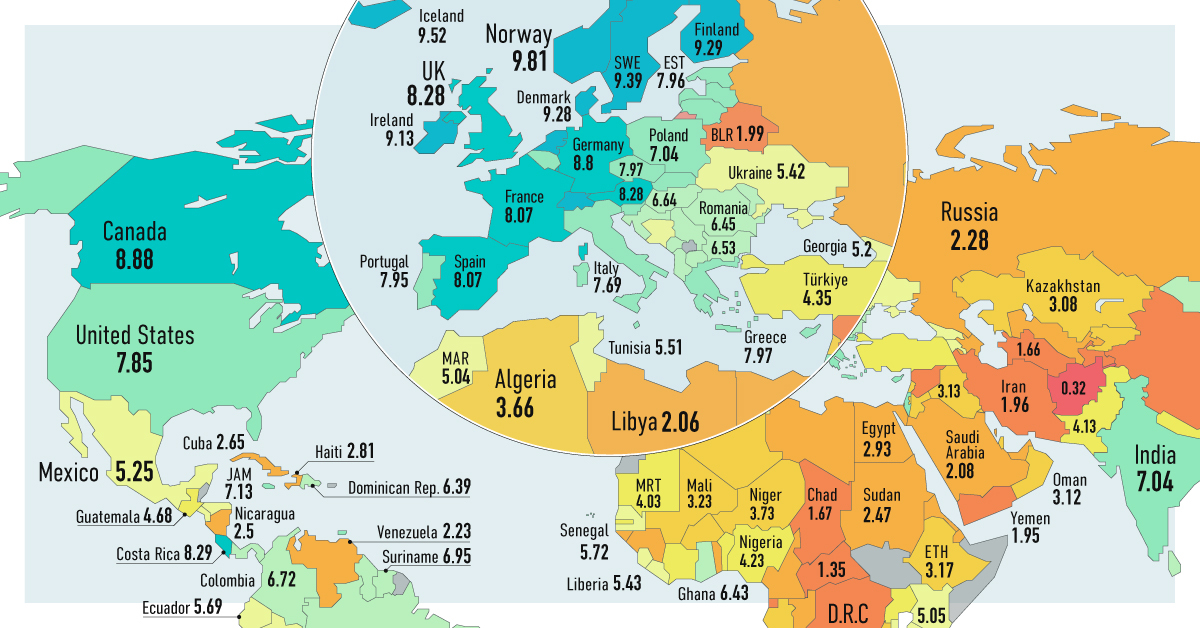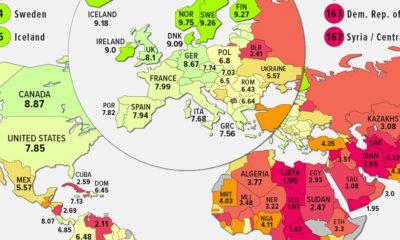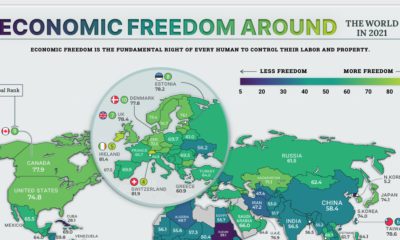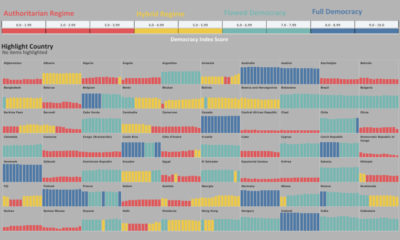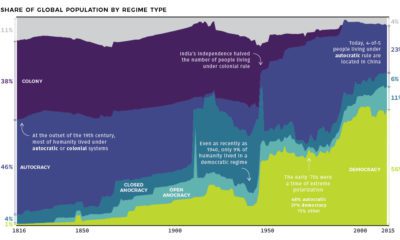Politics
Mapped: The State of Democracy Around the World
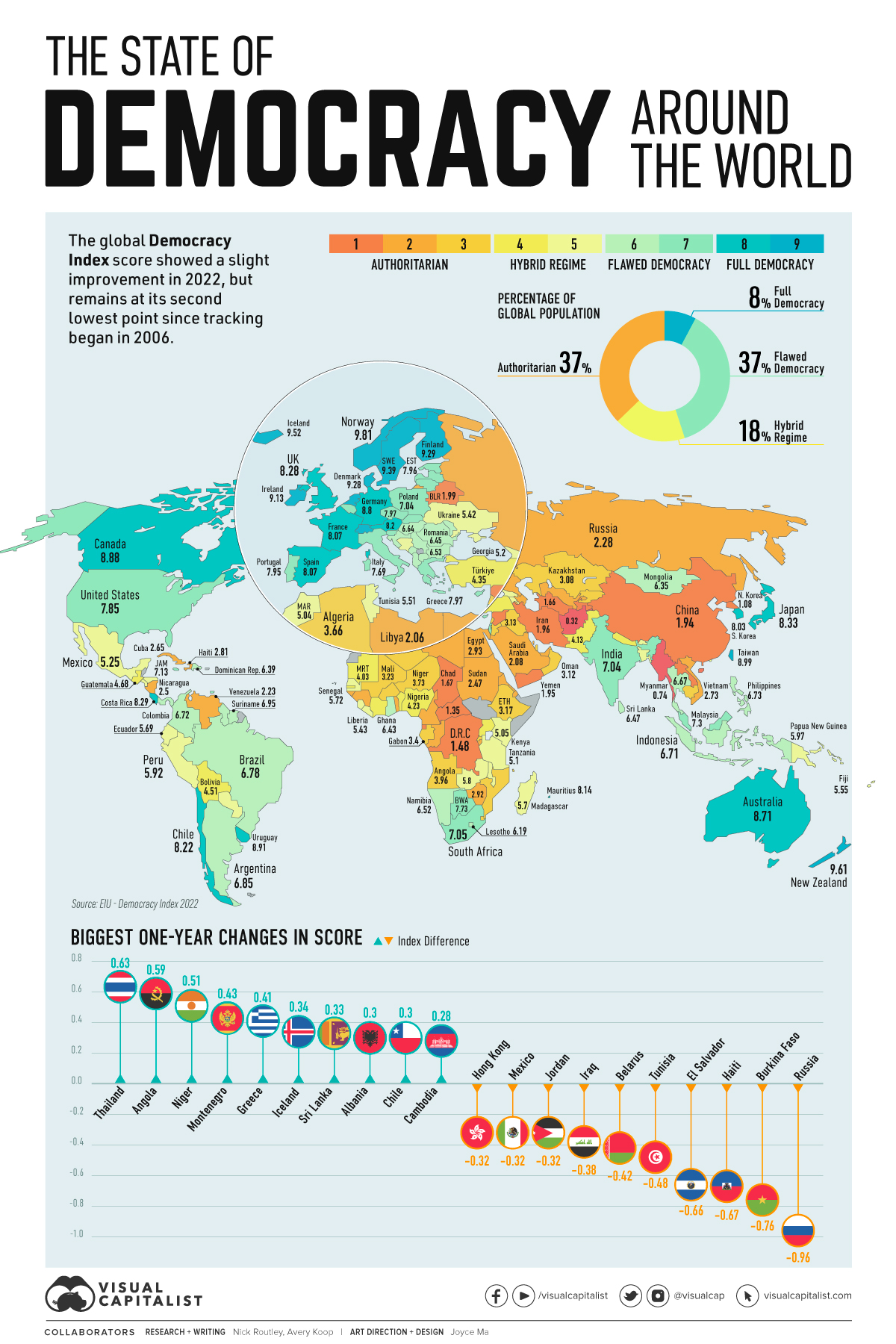
Mapped: The State of Democracy Around the World
Only 8% of the world’s population actually lives in a full, functioning democracy, according to the Economist Intelligence Unit (EIU).
Meanwhile, another 37% of people live in some type of “flawed democracy”, while 55% of the world does not live in democracy at all, based on the EIU’s latest Democracy Index Report.
Events such as the war in Ukraine and restrictive, long-lasting COVID-19 measures, have caused numerous declines to country democracy scores in recent years. Since the source report first began tracking scores in 2006, the global average has fallen from 5.52 to 5.29.
The Methodology
The EIU measures democracy by assessing 60 indicators across five key categories:
- Electoral process and pluralism
- Political culture
- Political participation
- Functioning of government
- Civil liberties
Each category has a rank of 0-10 based on how the indicators fared, and the overall democracy score is an average of each of the five categories. For example, here’s a look at the U.S.’ scoring out of 10 in each of the overall categories in 2022:
| Electoral process and pluralism | Functioning of government | Political participation | Political culture | Civil liberties |
|---|---|---|---|---|
| 9.17 | 6.43 | 8.89 | 6.25 | 8.53 |
🇺🇸 Total U.S. democracy score = 7.85 / 10
This score defines the U.S. as a flawed democracy and ranks it 30th overall in the world, down four spots from last year’s ranking. “Flawed” in this case simply means there are problems, ranging from poor political culture to governance issues, but flawed democracies are still considered to have free and fair elections, as well as civil liberties.
The World’s Democracies by Region
Below we map out the state of democracy across various regions around the world.
The Americas
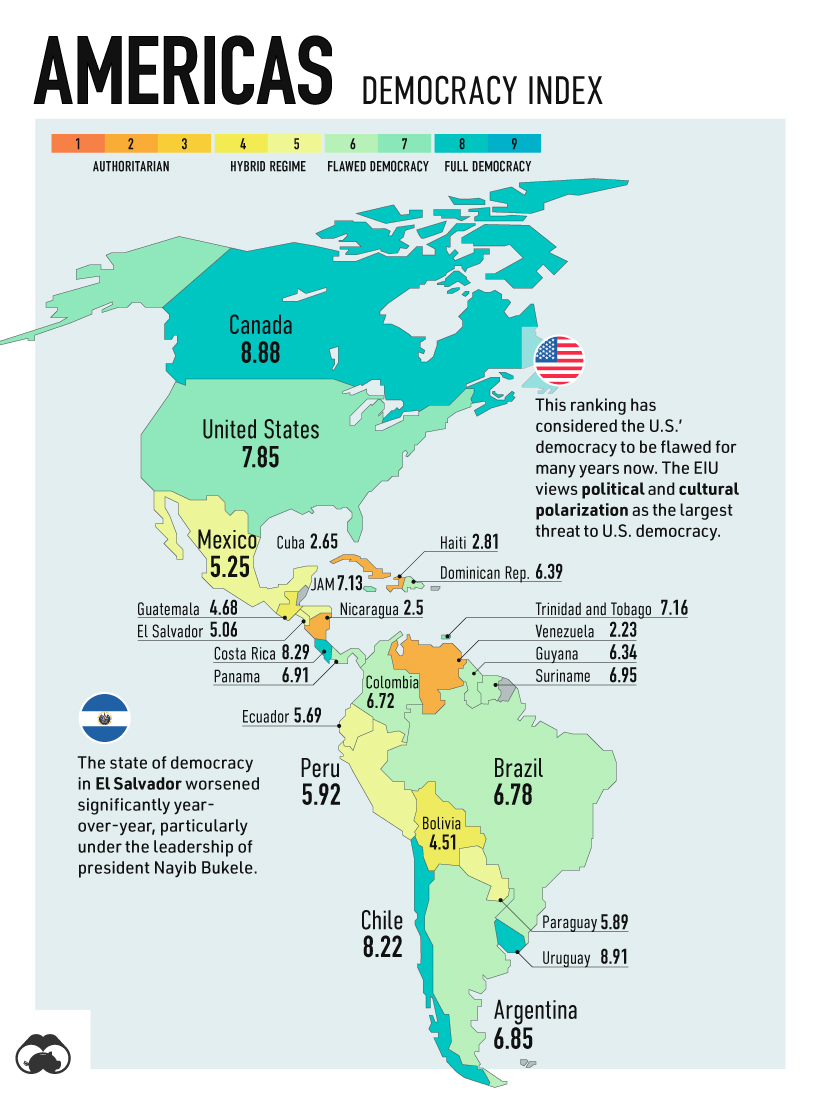
One of the best performers year-over-year was Chile, with its score increasing by nearly 0.3. The country moved out of the flawed democracy category last year, largely because of the shift towards constitutional reform alongside President Gabriel Boric moving towards the political center, reducing polarization.
Only three other countries in the Americas are also considered full democracies: Costa Rica, Canada, and Uruguay—the latter of which is #1 regionally.
On the flipside, some of the world’s worst performers year-over-year are located specifically in Latin America, namely: El Salvador and Haiti. Much of the low scores in the region are associated with high crime rates and corrupt governance.
Africa
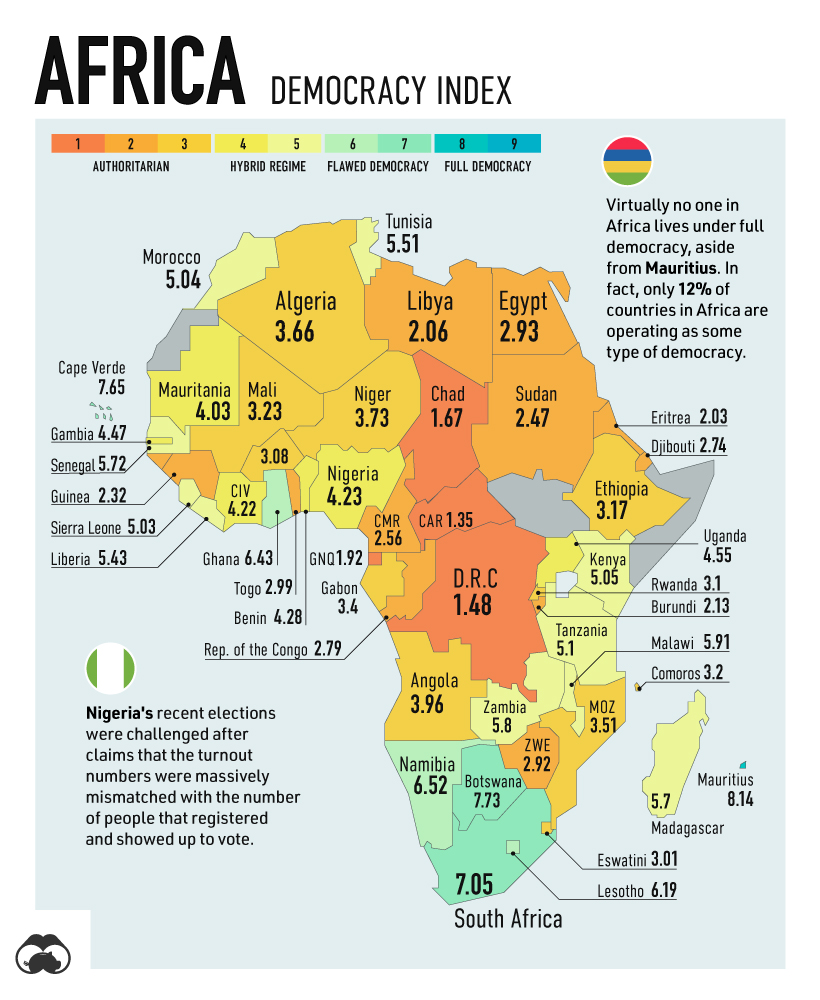
The only full democracy in Africa is the small, island nation of Mauritius. Overall, Africa is one of the lowest scoring regions with only five of the continent’s 54 countries ranking as some type of democracy.
Tunisia’s score decreased significantly in 2022. President Kais Saied dismissed parliament early in the year and took control of the electoral council, slowly shifting towards centralized power. And although there were critics, many have since been arrested, downgrading them in the EIU’s eyes from a flawed democracy to a hybrid regime.
Europe
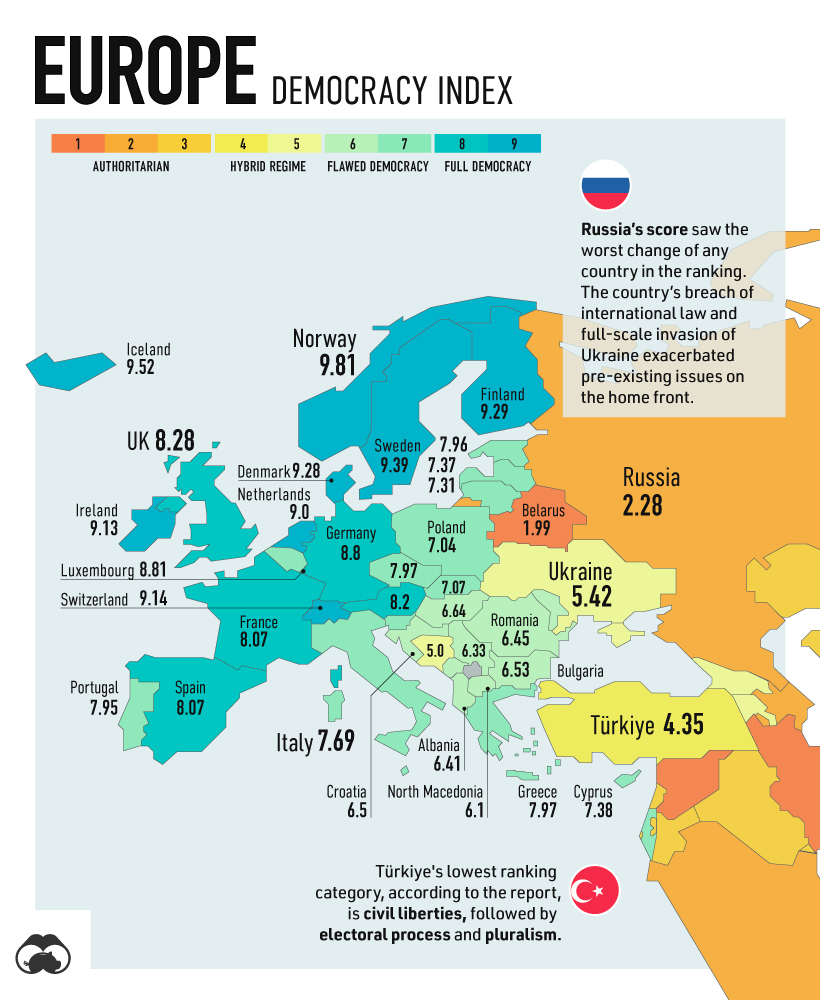
Spain and France regained status as full democracies in 2022, mainly improving in the civil liberties and functioning of government categories thanks to the easing of COVID-19 restrictions. However, both countries face political polarization; in Spain this is largely exemplified in the attitudes surrounding the Catalan separatist movement.
Some of the lowest scoring regimes in the region are in Russia and Belarus. Russia’s war in Ukraine has violated international law, as well as another country’s sovereignty, decimating its score by 0.96 in the index. Belarus has continually allied itself with Russia, allowing troops—and likely missiles—to enter Ukraine from its borders.
Oceania and East Asia
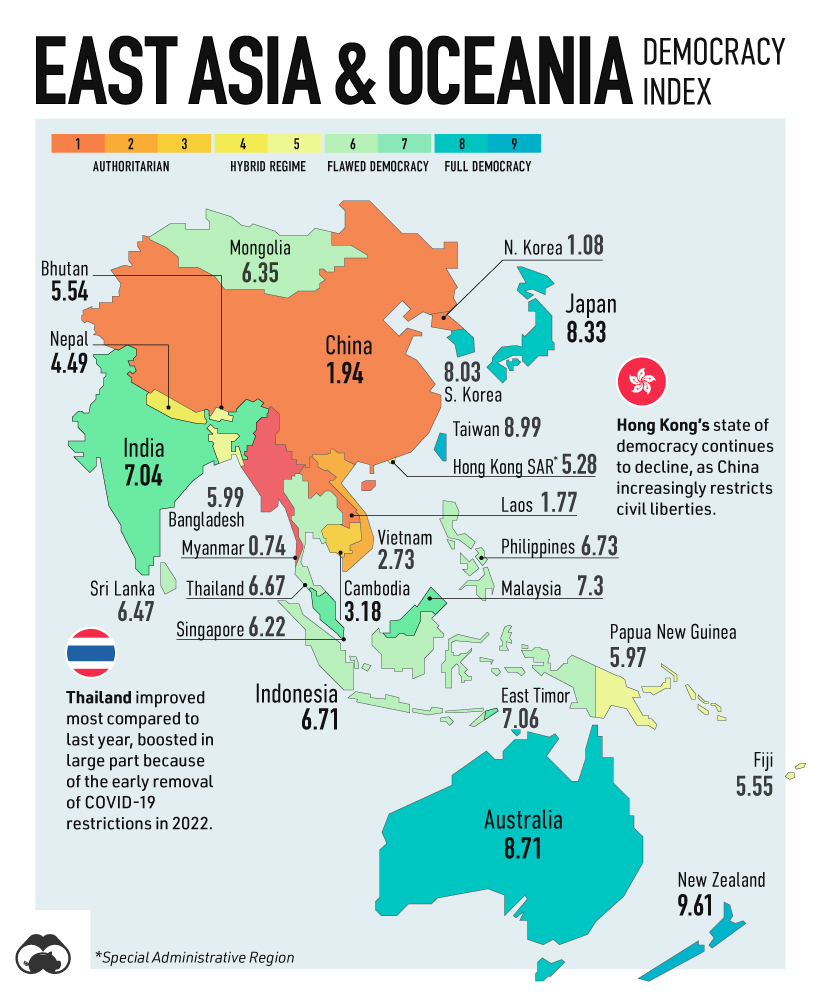
In this region, levels of democracy were severely affected by the COVID-19 pandemic. Hong Kong only removed restrictive policies like mask mandates in early 2023. In contrast, Thailand lifted these restrictions a year prior, providing more individual freedom, according to the report.
Malaysia’s fairly high score of 7.3 could face scrutiny, as the former Prime Minister, Muhyiddin Yassin, who was in office during COVID-19, is currently facing corruption charges for money laundering of COVID-19 stimulus package funds.
Central Asia and The Middle East
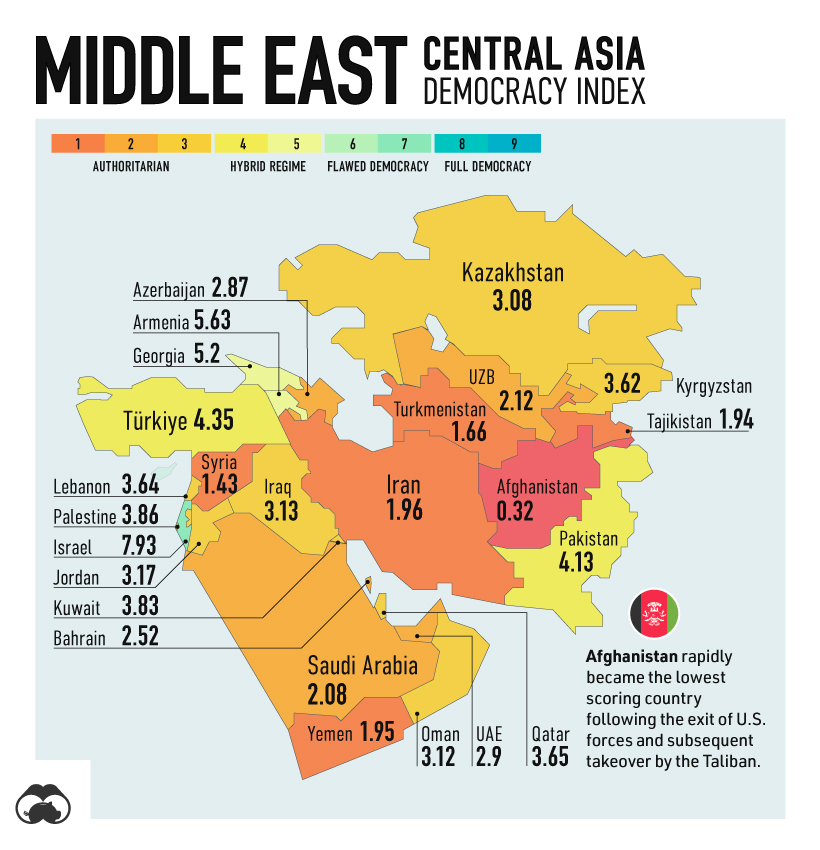
Finally, in the Middle East and Central Asia, there are no full democracies at all. The lowest scoring country globally is Afghanistan at only 0.32.
Israel, the only democracy of any kind of the region, actually moved down six spots in the global ranking from the year prior. Its lowest scoring category in 2022 was civil liberties. This year, the country is in the spotlight due to its judicial reforms proposed by the ruling nationalist party, and civil response has been strong. Mass protests continue around the country.
Where does this data come from?
Source: The Democracy Index Report by the Economist Intelligence Unit
Notes: This report, which has been produced by EIU since 2006, uses 60 indicators as well as public opinion polling and expert analysis to rank various countries. A detailed methodology can be found starting on page 66 of the report.
Economy
The Bloc Effect: International Trade with Geopolitical Allies on the Rise
Rising geopolitical tensions are shaping the future of international trade, but what is the effect on trading among G7 and BRICS countries?

The Bloc Effect: International Trade with Allies on the Rise
International trade has become increasingly fragmented over the last five years as countries have shifted to trading more with their geopolitical allies.
This graphic from The Hinrich Foundation, the first in a three-part series covering the future of trade, provides visual context to the growing divide in trade in G7 and pre-expansion BRICS countries, which are used as proxies for geopolitical blocs.
Trade Shifts in G7 and BRICS Countries
This analysis uses IMF data to examine differences in shares of exports within and between trading blocs from 2018 to 2023. For example, we looked at the percentage of China’s exports with other BRICS members as well as with G7 members to see how these proportions shifted in percentage points (pp) over time.
Countries traded nearly $270 billion more with allies in 2023 compared to 2018. This shift came at the expense of trade with rival blocs, which saw a decline of $314 billion.
Country Change in Exports Within Bloc (pp) Change in Exports With Other Bloc (pp)
🇮🇳 India 0.0 3.9
🇷🇺 Russia 0.7 -3.8
🇮🇹 Italy 0.8 -0.7
🇨🇦 Canada 0.9 -0.7
🇫🇷 France 1.0 -1.1
🇪🇺 EU 1.1 -1.5
🇩🇪 Germany 1.4 -2.1
🇿🇦 South Africa 1.5 1.5
🇺🇸 U.S. 1.6 -0.4
🇯🇵 Japan 2.0 -1.7
🇨🇳 China 2.1 -5.2
🇧🇷 Brazil 3.7 -3.3
🇬🇧 UK 10.2 0.5
All shifts reported are in percentage points. For example, the EU saw its share of exports to G7 countries rise from 74.3% in 2018 to 75.4% in 2023, which equates to a 1.1 percentage point increase.
The UK saw the largest uptick in trading with other countries within the G7 (+10.2 percentage points), namely the EU, as the post-Brexit trade slump to the region recovered.
Meanwhile, the U.S.-China trade dispute caused China’s share of exports to the G7 to fall by 5.2 percentage points from 2018 to 2023, the largest decline in our sample set. In fact, partly as a result of the conflict, the U.S. has by far the highest number of harmful tariffs in place.
The Russia-Ukraine War and ensuing sanctions by the West contributed to Russia’s share of exports to the G7 falling by 3.8 percentage points over the same timeframe.
India, South Africa, and the UK bucked the trend and continued to witness advances in exports with the opposing bloc.
Average Trade Shifts of G7 and BRICS Blocs
Though results varied significantly on a country-by-country basis, the broader trend towards favoring geopolitical allies in international trade is clear.
Bloc Change in Exports Within Bloc (pp) Change in Exports With Other Bloc (pp)
Average 2.1 -1.1
BRICS 1.6 -1.4
G7 incl. EU 2.4 -1.0
Overall, BRICS countries saw a larger shift away from exports with the other bloc, while for G7 countries the shift within their own bloc was more pronounced. This implies that though BRICS countries are trading less with the G7, they are relying more on trade partners outside their bloc to make up for the lost G7 share.
A Global Shift in International Trade and Geopolitical Proximity
The movement towards strengthening trade relations based on geopolitical proximity is a global trend.
The United Nations categorizes countries along a scale of geopolitical proximity based on UN voting records.
According to the organization’s analysis, international trade between geopolitically close countries rose from the first quarter of 2022 (when Russia first invaded Ukraine) to the third quarter of 2023 by over 6%. Conversely, trade with geopolitically distant countries declined.
The second piece in this series will explore China’s gradual move away from using the U.S. dollar in trade settlements.

Visit the Hinrich Foundation to learn more about the future of geopolitical trade

-

 Economy2 days ago
Economy2 days agoEconomic Growth Forecasts for G7 and BRICS Countries in 2024
The IMF has released its economic growth forecasts for 2024. How do the G7 and BRICS countries compare?
-

 United States2 weeks ago
United States2 weeks agoRanked: The Largest U.S. Corporations by Number of Employees
We visualized the top U.S. companies by employees, revealing the massive scale of retailers like Walmart, Target, and Home Depot.
-

 Economy2 weeks ago
Economy2 weeks agoWhere U.S. Inflation Hit the Hardest in March 2024
We visualized product categories that saw the highest % increase in price due to U.S. inflation as of March 2024.
-

 Economy1 month ago
Economy1 month agoG20 Inflation Rates: Feb 2024 vs COVID Peak
We visualize inflation rates across G20 countries as of Feb 2024, in the context of their COVID-19 pandemic peak.
-

 Economy1 month ago
Economy1 month agoMapped: Unemployment Claims by State
This visual heatmap of unemployment claims by state highlights New York, California, and Alaska leading the country by a wide margin.
-

 Economy2 months ago
Economy2 months agoConfidence in the Global Economy, by Country
Will the global economy be stronger in 2024 than in 2023?
-

 Misc1 week ago
Misc1 week agoHow Hard Is It to Get Into an Ivy League School?
-

 Technology2 weeks ago
Technology2 weeks agoRanked: Semiconductor Companies by Industry Revenue Share
-

 Markets2 weeks ago
Markets2 weeks agoRanked: The World’s Top Flight Routes, by Revenue
-

 Countries2 weeks ago
Countries2 weeks agoPopulation Projections: The World’s 6 Largest Countries in 2075
-

 Markets2 weeks ago
Markets2 weeks agoThe Top 10 States by Real GDP Growth in 2023
-

 Demographics2 weeks ago
Demographics2 weeks agoThe Smallest Gender Wage Gaps in OECD Countries
-

 Economy2 weeks ago
Economy2 weeks agoWhere U.S. Inflation Hit the Hardest in March 2024
-

 Green2 weeks ago
Green2 weeks agoTop Countries By Forest Growth Since 2001



